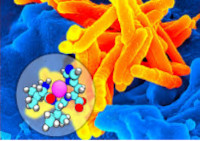Anti-Tuberculosis Study of Mycobacterium tuberculosis H37Rv of Aspilia pluriceta Extract and Fractions
DOI:
https://doi.org/10.26538/tjnpr/v8i3.7Keywords:
Mycobacterium tuberculosis H27Rv, phytochemicals, Aspilia pluriceta, Anti-tuberculosisAbstract
Tuberculosis (TB) is a chronic infectious disease caused by Mycobacterium tuberculosis (Mtb). Mtb affects not only the respiratory system but also other body organs, such as the lungs, leading to pulmonary and extrapulmonary TB, the brain, and the spine. Aspilia pluriceta from Meru Betiri National Park in Indonesia is one plant with potential for Mycobacterium tuberculosis. This study aimed to determine the antituberculosis activity of extracts and fractions of Aspilia pluriceta against Mycobacterium tuberculosis H37Rv. Aspilia pluriceta was extracted by maceration with methanol, and the crude methanol extract was fractionated successively with hexane, dichloromethane (DCM), and ethyl acetate. The phytochemical of the crude extract was determined by TLC and visualised by spraying with appropriate staining reagents. The crude extract and fractions of Aspilia pluriceta at concentrations 25, 100, 500, and 1000 µg/mL, respectively, were tested against the H37Rv strain of Mycobacterium tuberculosis using the resazurin method and analysed by an ELISA reader. Isoniazid, a first-line drug used in the treatment of tuberculosis, was used as the positive control agent. The phytochemical screening test revealed the presence of saponins, alkaloids, tannins, flavonoids, and terpenes. The results of anti-TB showed that the ethyl acetate fraction exhibited the most potent activity against Mycobacterium tuberculosis H37Rv with an IC50 value of 0.48 µg/mL. The crude extract and
other fractions exhibited low activity against the tested organism. The findings showed that the plant holds potential for phytochemicals with antituberculosis activity, which could be further explored through bioactivity-guided isolation for leads against Mycobacterium tuberculosis.
References
World Health Organization. Global Tuberculosis Report 2020. Geneva: WHO. 2020
Njeru, SN and JM Muema. Antimicrobial activity, phytochemical characterisation, and Gas ChromatographyMass Spectrometry analysis of Aspilia pluriseta Schweinf. extracts. Heliyon. 2020; 6(10):e05195.
Njeru, SN and JM Muema. In vitro cytotoxicity of Aspilia pluriseta Schweinf. extract fractions. BMC Research Notes. 2021; 14(1):4–7.
Prastyo, P. and A. Sri Rahayoe. 2018. Buchner filtering method as an alternative to simple filtering in adsorption experiments in Physical Chemistry practicum. Indones. J. Med. Lab.. 2018; 1(1):24.
Carvalho, R., J. de Sonneville, OW Stockhammer, NDL Savage, WJ Veneman, THM Ottenhoff, RP Dirks, AH Meijer, and HP Spaink. A High-throughput screen for Tuberculosis progression. PLOS ONE. 2011; 6(2):1–8.
Franzblau, SG, RS Witzig, JC Mclaughlin, P. Torres, G. Madico, A. Hernandez, MT Degnan, MB Cook, VK Quenzer, RM Ferguson, and RH Gilman.. Rapid, Lowtechnology MIC determination with Clinical Mycobacterium tuberculosis isolates by using The Microplate Alamar Blue Assay. J. Clin. Microbiol. 1998; 36(2):362–366.
Ordas, A., RJ Raterink, F. Cunningham, HJ Jansen, MI Wiweger, S. Jong- Raadsen, S. Bos, RH Bates, D. Barros, AH Meijer, RJ Vreeken, L. Ballell- Pages, RP Dirks, T. Hankemeier, and H. P. Spaink. Testing tuberculosis drug efficacy in a zebrafish High-throughput translational
medicine screen. Antimicrob Agents Chemother.2015; 59(2):753–762.
Palomino, J.C. and F. Portaels. Simple procedure for Drug susceptibility testing of Mycobacterium tuberculosis using a commercial colorimetic assay. Eur. J. Clin. Microbiol. Infect. Dis. 1999; 18(5):380–383.
Patil, SS, ST Mohite, SA Kulkarni, and US Udgaonkar. 2014. Resazurin tube method: Rapid, Simple, and Inexpensive method for Detection of Drug Resistance in the clinical isolates of Mycobacterium tuberculosis. J. Glob. Infect. 2014; 6(4):151–156.
Pavan, FR, CQF Leite, RG Coelho, ID Coutinho, NK Honda, CAL Cardoso, W. Vilegas, SR De Andrade Leite, and DN Sato. Evaluation of anti-Mycobacterium tuberculosis activity of Campomanesia adamantium (Myrtaceae). Quimica Nova. 2009; 32(5):1222–1226.
Piero, NM and M. N Joan. Hypoglycemic Activity of Some Kenyan Plants Traditionally Used to Manage Diabetes Mellitus in Eastern Province. Diabetes Metab J. 2011; 02(08):2–7.

Published
How to Cite
Issue
Section
License
Copyright (c) 2024 Tropical Journal of Natural Product Research (TJNPR)

This work is licensed under a Creative Commons Attribution-NonCommercial-NoDerivatives 4.0 International License.

















